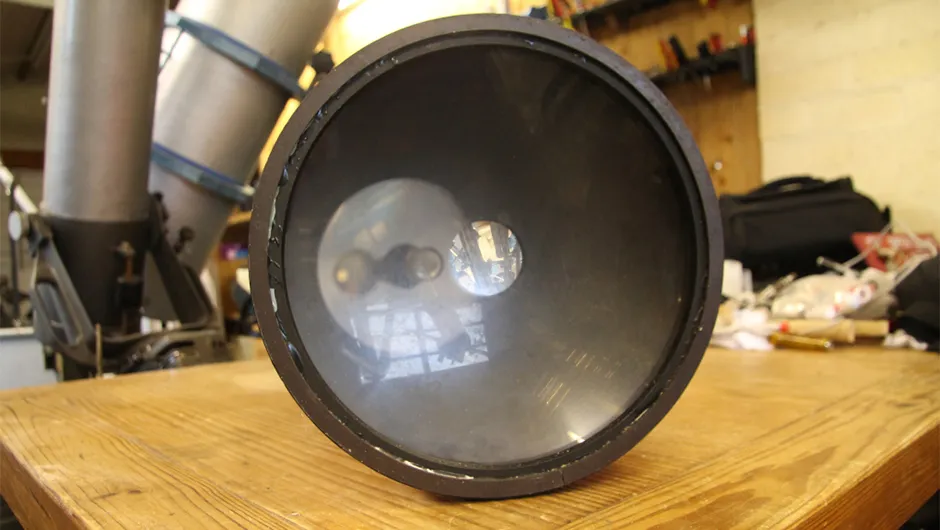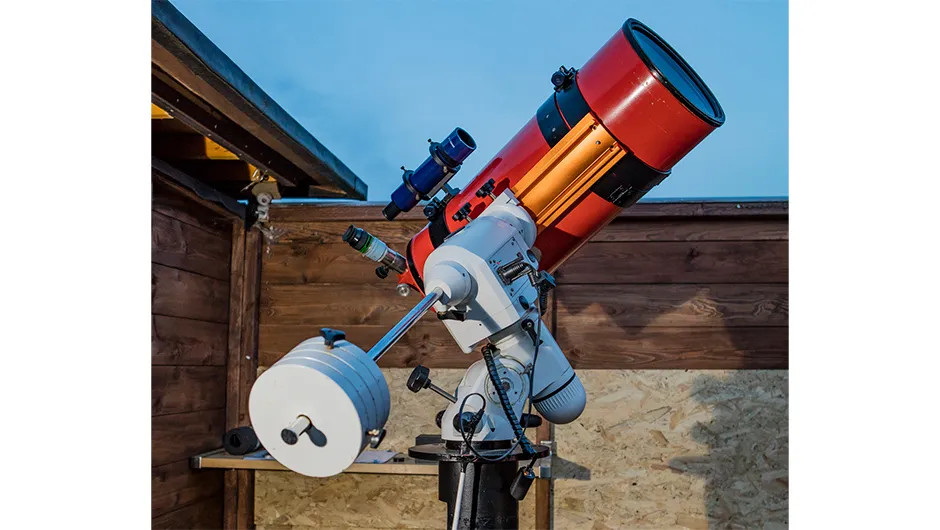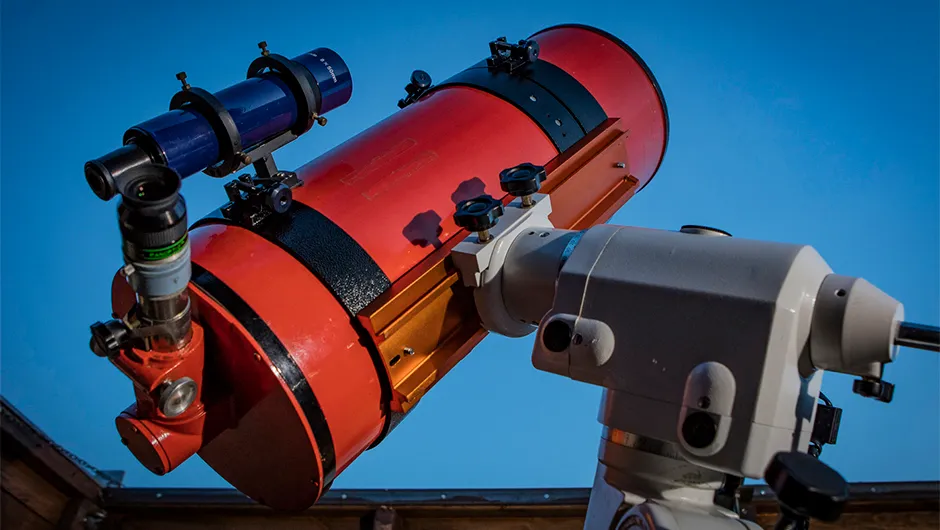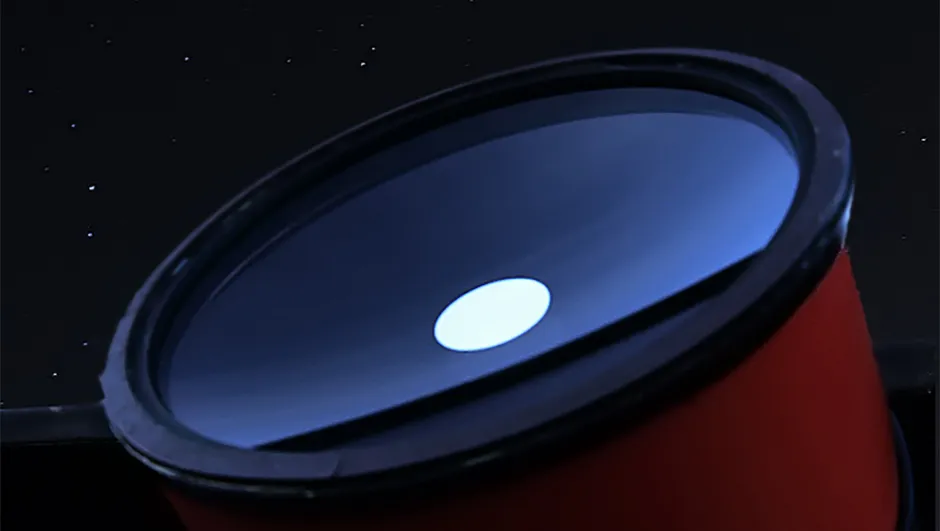Dave Tatters (left) and Stewart Hepton (right) of Sunderland Astronomical Society inspect the newly-refurbished Perseus. Image Credit: Larry Bedigan
While the north east of England is well known for mining and heavy industry, until 1985 it also had a hand in producing quality telescopes, courtesy of a company called Sir Howard Grubb, Parsons and Co. Ltd.
The roots of this enterprise go back to the famous Victorian telescope maker Howard Grubb, who established the Grubb Telescope Company in Dublin in 1833 before the business was moved across the Irish Sea to Newcastle Upon Tyne in 1925.
Acquired by the British engineer Charles Parsons, the company was renamed and became known colloquially as Grubb Parsons.
Here, many large research telescopes were built that are still operational today, including the 98-inch Isaac Newton Telescope built in 1967 for the Royal Observatory at Herstmonceux, now in use on the island of La Palma in the Canaries.
In the early 1970s, the company also built the mirror for the Anglo-Australian Telescope, currently in use at Siding Spring Observatory in Australia, and built the 1985 William Herschel Telescope, also now situated in the Canary Islands, which was delivered shortly before Grubb Parsons ceased trading.
In its final years, Grubb Parsons tried to get a foot into the amateur telescope market, and the telescope of this story comes from that short era.

The Tyne area benefits from many active astronomical groups that encourage amateurs to come together, including our own Sunderland Astronomical Society.
The society counts amongst its members several skilled engineers; something that is complemented by close links to Durham University, a major centre for astrophysics and cosmology.

It was through the link with the University that, some 17 years ago, we came into possession of a Grubb Parsons 'Perseus' telescope.
Two telescopes, the Perseus and the Andromeda, were produced in the 1980s by Grubb Parsons as instruments for the amateur astronomer.
The Andromeda was a 5-inch Newtonian on a short pillar mount.
These instruments were manufactured and tested under the guidance of Grubbs' Optical Manager David Sinden, a long-standing member of the British Astronomical Association and a revered figure in telescope-making circles.
Sinden was responsible for constructing the optics of many of the large telescopes manufactured by the firm, and in 1979 he founded the Sinden Optical Company, which ceased trading when he passed away in 2005.
The exact optical structure of the Perseus has been a topic of debate over the years.
Because of the meniscus lens at the front, it may be considered a Maksutov of sorts, but it has an additional lens system in the secondary baffle tube that is not usually included in this configuration.
It might be described as a hybrid design, and while it is not known how many were made, the Perseus is extremely rare.
Sunderland Astronomical Society's public observatory at Washington Wetlands Centre has two observatories, one of which boasts a recently-renovated roll-off roof structure, and so it seemed an ideal location to mount this unique instrument.
Consequently, the restoration project commenced in August 2017.

Jurgen Schmoll, an astronomer and instrument scientist at Durham University, and a good friend of the society, was approached to complete an optical overhaul and re-collimation of the scope.
Jurgen devotes much of his free time to rebuilding astronomical instruments, including several of his own that are currently awaiting installation in a new observatory he has under construction.
Despite many years in storage, he found that the Perseus’s optics, whilst dirty, were in generally good condition.
“The telescope had no cover, so the optics looked rather blind to begin with,” Jurgen says.
“The design looked quite unusual to me, as it looked like a Maksutov-Cassegrain but with lenses in the baffle, which in a classical Mak would be empty.
The corrector plate had a circular spot in the centre, a design of the Maksutov-Cassegrain system pioneered by the US American optician John Gregory.”
In order to clean the instrument, the telescope tube had to be disassembled, allowing detailed examination and a determination of the exact optical type.
This revealed what is best described as ‘relay optics’ which reduced the secondary obscuration, moving the focal point from inside the tube to the outside where it can be accessed, thus increasing ‘contrast’ beyond that typically found in a 9.5-inch telescope of this type.
The focus system, which diverts the eyepiece position at right angles to the tube, is unusual as a diagonal mirror is fixed in place, followed by a long focuser and a sliding tube.
The sliding tube is used for coarse focusing while a rack and pinion mechanism allows finer adjustment.
The mechanics were quite seized and, as a result, required lubrication.
When taken from storage, surprisingly, the corrector plate was unprotected and lacked its original cover.
This required the manufacture of a new lid, fashioned from wood but with a magnetic attachment to the tube.

Following completion of the optical and mechanical refurbishment of the telescope, the next stage was the provision of an appropriate mount and ‘fitting out’ of the tube.
While in its original configuration the scope was mounted on a manually operated fork, the intention was to place it on a Sky-Watcher EQ6 German equatorial mount already installed at the observatory.
Tube rings inclusive of a Losmandy dovetail were fitted in early March 2018, at which time ‘marrying’ the scope to its new mount was first tested.
The combination of large aperture and long focal length will make this telescope a perfect lunar and planetary instrument and will play its part in the society's extensive outreach programme.

The support of the Frank Acfield Fund, targeting as it does science education for the young, fits perfectly Sunderland Astronomical Society's objective of encouraging future budding astronomers.
As well as public viewing nights, our observatory hosts visits by youth organisations such as the Scout movement.
Members are also involved with local schools, providing both daytime solar viewing as well as evening sessions at the school premises.
Well provided with expertise in all aspects of the subject and an extensive array of instruments belonging both to the society and its membership, these visits generally include inspirational talks alongside equally inspirational viewing.

Throughout the winter season the membership and public are offered a monthly lecture programme with speakers provided from the membership, the University, and other areas of expertise.
Bringing the Perseus back into use will complement the society's other large instrument, a Meade 14-inch Schmidt-Cassegrain, and extend its ability to promote astronomy throughout the north east.
“After I returned it to Sunderland AS, tube rings were added and I look forward to finally observing with it,” Jurgen says.
“This will be the time to finalise alignment and to find out how well this system really works.”
